Visual learning plays a crucial role in enhancing English language acquisition by utilizing images, videos, and other visual aids to improve comprehension and retention. By catering to diverse learning styles, this approach not only simplifies complex concepts but also boosts student engagement, making the language learning experience more interactive and enjoyable.
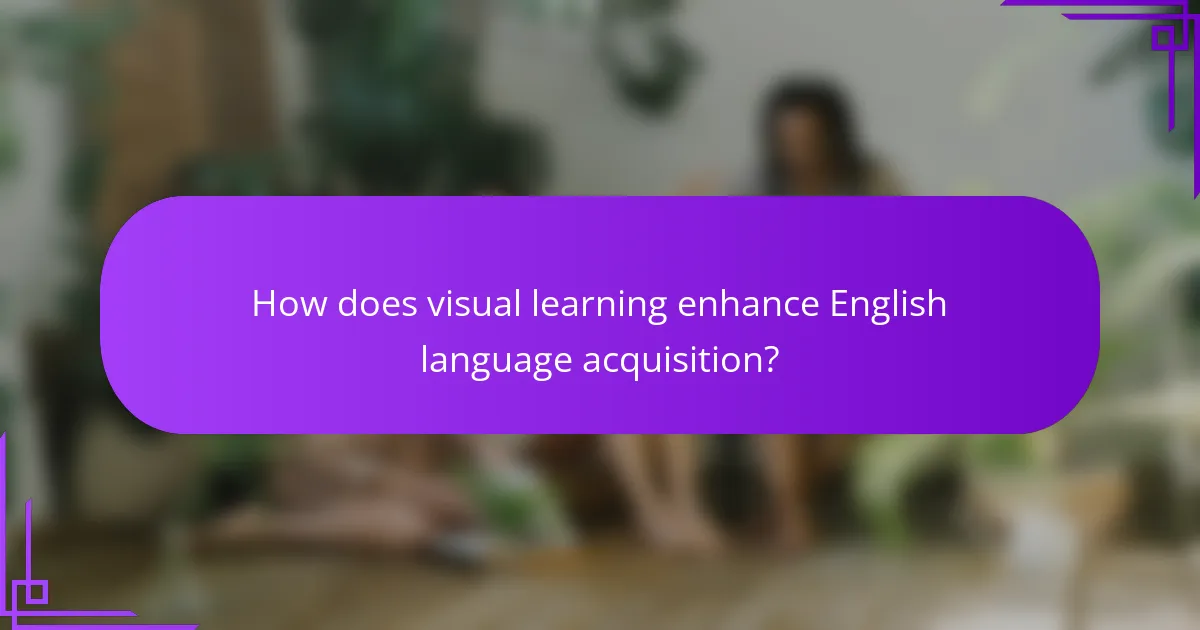
How does visual learning enhance English language acquisition?
Visual learning significantly enhances English language acquisition by leveraging images, videos, and other visual aids to facilitate understanding. This approach helps learners grasp complex concepts more easily and retain new vocabulary and grammar structures more effectively.
Improved comprehension through imagery
Imagery plays a crucial role in enhancing comprehension for English language learners. Visual representations of words and concepts can clarify meanings that might be abstract or difficult to understand through text alone. For instance, using pictures to illustrate vocabulary words can help learners make connections and contextualize their use.
Incorporating infographics and charts can also aid in breaking down complex information, making it more digestible. This method is particularly effective for visual learners who may struggle with traditional text-based instruction.
Increased retention via visual aids
Visual aids significantly boost retention rates for language learners. Studies suggest that learners who engage with visual content can remember information for longer periods compared to those who rely solely on auditory or textual methods. Flashcards with images, for example, can reinforce vocabulary retention by associating words with visual cues.
Utilizing videos and animations can further enhance memory retention by providing dynamic and engaging content. This multisensory approach caters to various learning styles, making it easier for students to recall information when needed.
Engagement through interactive content
Interactive visual content fosters greater engagement among English language learners. Tools such as interactive quizzes, games, and multimedia presentations encourage active participation, which can lead to a deeper understanding of the language. For example, language learning apps that incorporate gamified elements can motivate learners to practice regularly.
Additionally, collaborative projects that involve creating visual presentations can enhance peer interaction and communication skills. This not only makes learning more enjoyable but also builds confidence in using the language in real-life situations.
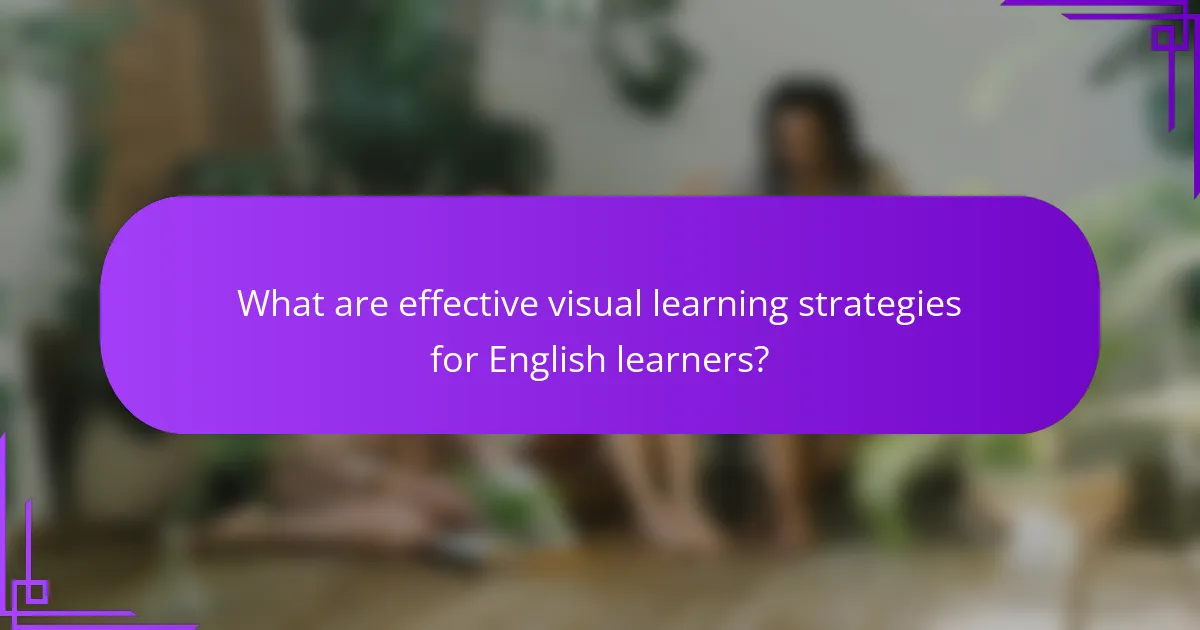
What are effective visual learning strategies for English learners?
Effective visual learning strategies for English learners include using various visual aids that enhance comprehension and retention. These strategies leverage imagery to facilitate understanding and engagement, making language acquisition more effective.
Use of infographics and charts
Infographics and charts present information in a visually appealing format, helping English learners grasp complex concepts quickly. They can simplify data and highlight relationships between ideas, making it easier to remember vocabulary and grammar rules.
When creating infographics, focus on clarity and relevance. Use simple visuals and limit text to key points. Tools like Canva or Piktochart can help in designing effective infographics tailored to specific language topics.
Incorporation of videos and animations
Videos and animations can significantly enhance language learning by providing context and visual cues. They engage learners by combining auditory and visual elements, which can improve comprehension and retention rates.
To maximize effectiveness, choose videos that are age-appropriate and culturally relevant. Short clips, ideally under five minutes, can maintain attention and reinforce language concepts without overwhelming learners.
Application of mind maps
Mind maps are a powerful tool for organizing thoughts and ideas visually. They help English learners connect vocabulary and concepts, making it easier to recall information during speaking or writing tasks.
When creating a mind map, start with a central idea and branch out with related terms and concepts. Use colors and images to differentiate sections, which can aid memory retention. This technique encourages active participation and can be done individually or in groups for collaborative learning.
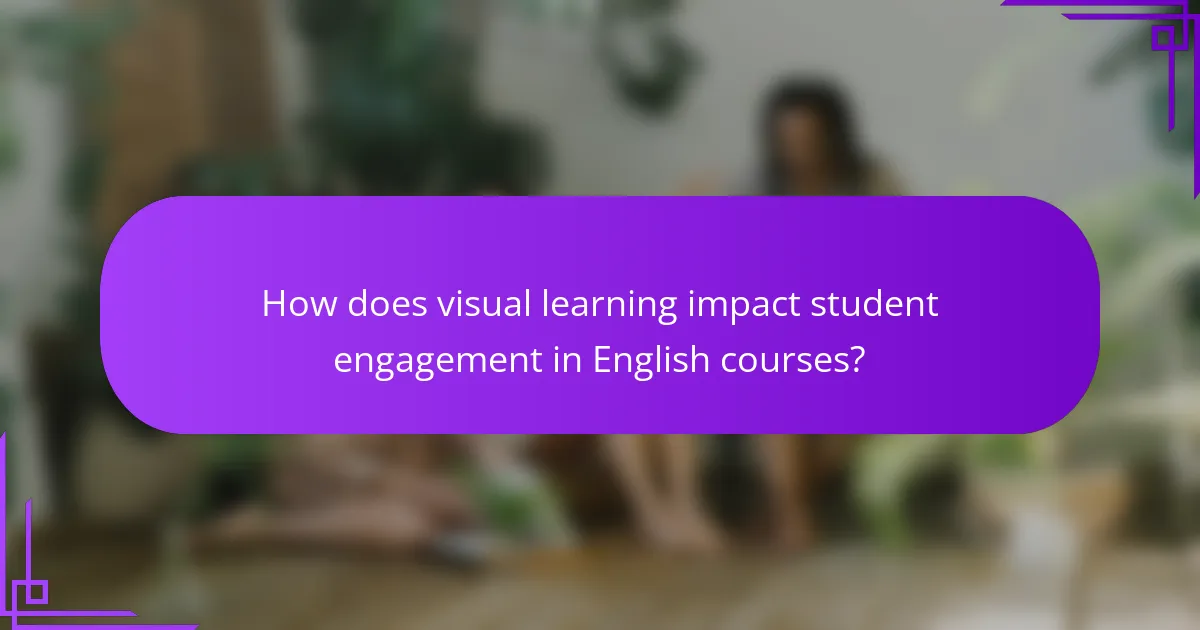
How does visual learning impact student engagement in English courses?
Visual learning significantly enhances student engagement in English courses by incorporating images, videos, and other visual aids that capture attention and facilitate understanding. This approach caters to various learning styles, making lessons more interactive and enjoyable for students.
Higher participation rates
Utilizing visual elements in English lessons can lead to higher participation rates among students. When lessons include engaging visuals, students are more likely to contribute to discussions and activities. For instance, using infographics or videos can stimulate interest and prompt students to share their thoughts and insights.
Teachers can encourage participation by integrating visuals that relate to the curriculum, such as illustrations of literary themes or character maps. This not only makes the content more relatable but also invites students to engage more actively in their learning process.
Enhanced motivation through visual stimuli
Visual stimuli can significantly boost student motivation in English courses. When students encounter colorful and dynamic visuals, their interest in the material increases, leading to a more enthusiastic learning environment. For example, incorporating multimedia presentations can make complex topics more accessible and enjoyable.
To maximize motivation, educators should select visuals that are relevant and appealing to their students. Using culturally relevant images or popular media references can resonate with learners, making them more eager to participate and absorb the material. Avoiding overly complex visuals is crucial, as clarity should always take precedence to maintain engagement.

What role do online courses play in visual learning for English?
Online courses significantly enhance visual learning for English by providing interactive and engaging content that caters to various learning styles. These courses utilize videos, infographics, and visual aids to facilitate language acquisition and retention, making the learning experience more dynamic and effective.
Access to diverse multimedia resources
Online courses offer a wide range of multimedia resources that support visual learning. Learners can access videos, animations, and interactive quizzes that help illustrate complex concepts and vocabulary in context. This variety not only aids comprehension but also keeps learners engaged and motivated.
For example, a course might include video lessons featuring native speakers, which can improve pronunciation and listening skills. Additionally, infographics can summarize key grammar rules or vocabulary themes, making them easier to remember.
Flexibility in learning pace and style
Online courses provide the flexibility for learners to progress at their own pace, which is crucial for effective language acquisition. Students can revisit challenging materials or accelerate through familiar topics, allowing for a personalized learning experience that suits individual needs.
This adaptability is particularly beneficial for visual learners who may require more time to process information presented in a visual format. For instance, learners can pause and replay videos or spend extra time on interactive exercises, ensuring they fully grasp the material before moving on.
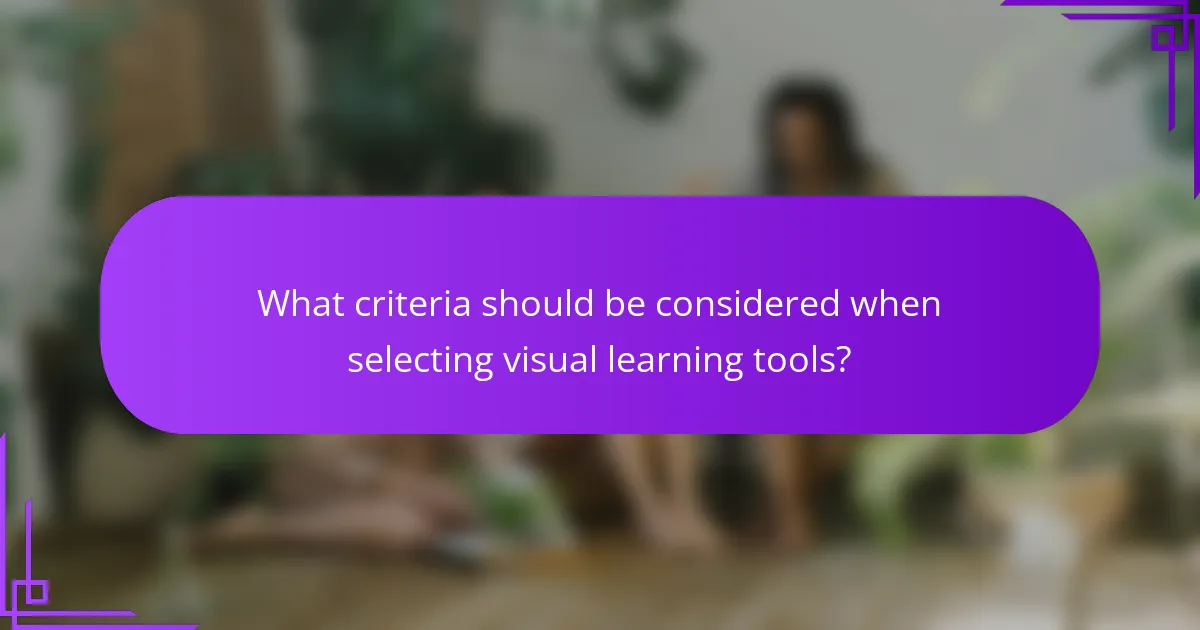
What criteria should be considered when selecting visual learning tools?
When selecting visual learning tools, it is essential to consider their alignment with educational goals, user-friendliness, and accessibility. These criteria ensure that the tools effectively enhance English language acquisition, retention, and engagement.
Alignment with learning objectives
Visual learning tools should directly support the specific learning objectives of the English language curriculum. This means evaluating whether the tool facilitates vocabulary acquisition, grammar understanding, or reading comprehension. For example, a tool that uses infographics to illustrate grammar rules can be more effective than one that merely presents text.
Additionally, consider how well the tool integrates with existing lesson plans. Tools that can be easily adapted to various teaching methods or that offer customizable features can enhance their effectiveness in meeting diverse learning needs.
User-friendliness and accessibility
User-friendliness is crucial for ensuring that both educators and learners can navigate visual learning tools without frustration. A tool should have an intuitive interface, clear instructions, and minimal technical barriers. For instance, tools that require extensive training may hinder rather than help the learning process.
Accessibility is equally important, particularly for learners with disabilities. Tools should comply with accessibility standards, such as the Web Content Accessibility Guidelines (WCAG), to ensure that all students can benefit from them. This includes features like screen reader compatibility and options for text resizing or color contrast adjustments.
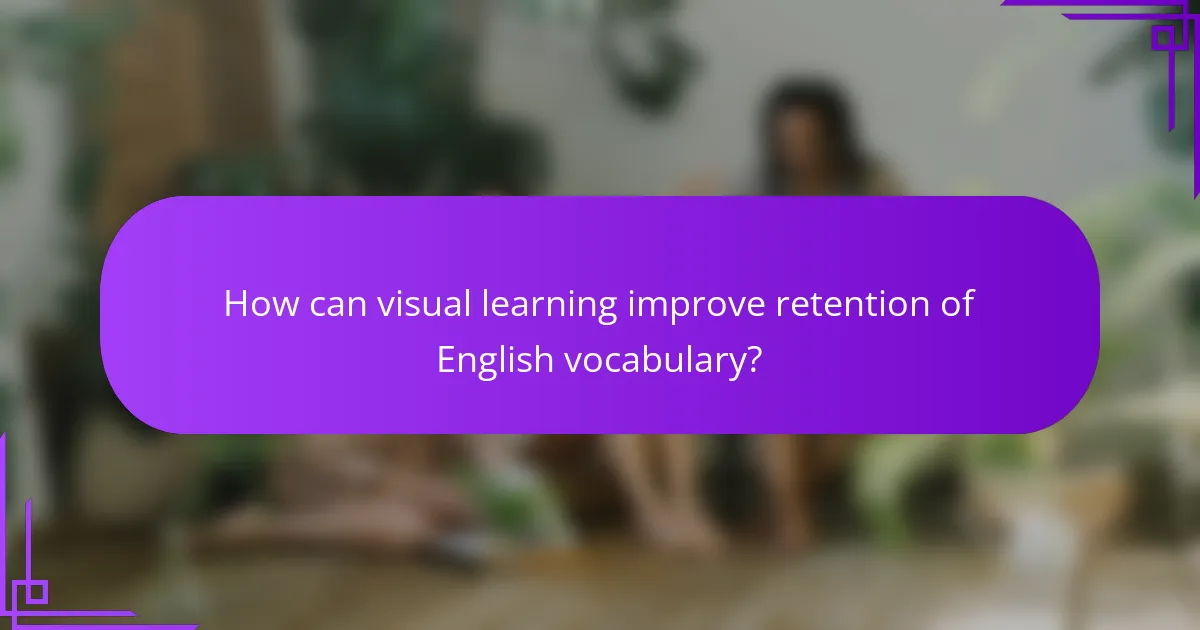
How can visual learning improve retention of English vocabulary?
Visual learning enhances retention of English vocabulary by creating strong associations between words and images. This method leverages the brain’s ability to remember visual information more effectively than text alone, leading to improved recall and understanding.
Association of words with images
Associating words with images helps learners create mental connections that facilitate memory. For instance, pairing the word “apple” with a picture of an apple allows learners to visualize the object, making it easier to remember the word. This technique is particularly effective for beginners who may struggle with abstract concepts.
Using images that are culturally relevant can further enhance this association. For example, using local fruits or common objects familiar to learners can make the learning experience more relatable and impactful.
Use of flashcards with visuals
Flashcards that incorporate visuals can significantly boost vocabulary retention. Each card should feature a word on one side and a corresponding image on the other, allowing learners to test their recall in an engaging way. This method encourages active learning and can be used in both individual and group settings.
To maximize effectiveness, learners should regularly review their flashcards, ideally in short sessions spread over time. This spaced repetition helps reinforce memory and ensures that vocabulary is retained long-term. Avoid overcrowding flashcards with too much information; focus on one word and one image per card for clarity.
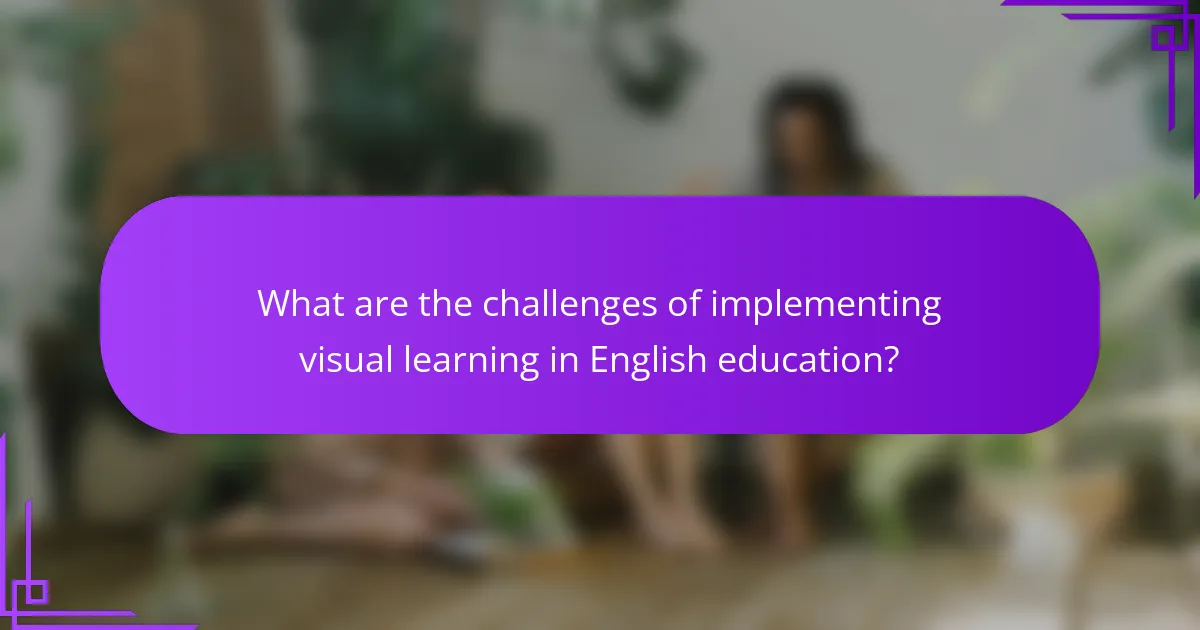
What are the challenges of implementing visual learning in English education?
Implementing visual learning in English education faces several challenges, including limited resources and insufficient teacher training. These obstacles can hinder the effective integration of visual strategies that enhance language acquisition and retention.
Resource limitations in classrooms
Many classrooms lack the necessary resources to effectively implement visual learning techniques. This can include insufficient access to technology, such as projectors or interactive whiteboards, as well as a shortage of visual aids like charts, diagrams, and videos.
Budget constraints often limit schools’ ability to invest in these tools. Teachers may need to be creative in utilizing low-cost or free resources, such as online platforms that offer visual content, to supplement their teaching.
Teacher training and preparedness
Teachers may not receive adequate training in visual learning strategies, which can affect their confidence and effectiveness in using these methods. Professional development programs should focus on equipping educators with the skills to incorporate visual aids into their lesson plans.
Additionally, ongoing support and collaboration among teachers can enhance their preparedness. Schools can foster a culture of sharing best practices and resources to help educators feel more comfortable with visual learning techniques.


